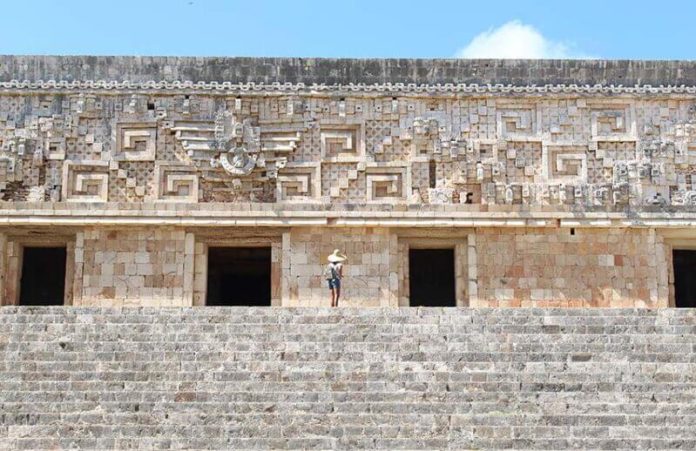Uxmal, declared a UNESCO World Heritage site in 1996, is one of the most beautiful ancient Maya ruins in the Yucatán Peninsula. Situated around 80 kilometers from Mérida, the ancient city is part of the Ruta Puuc travel route — which covers several archaeological sites, cenotes and other attractions.
The city’s name, pronounced “oosh-mal,” means “thrice built,” which Mexico’s National Institute of Anthropology and History (INAH) believes may refer to the site’s successive occupations. The name also translates to “the place abundantly harvested.”
Archaeologists estimate that the Maya occupied Uxmal as far back as 500 B.C., although the city’s peak was around A.D. 700–950. Between the 9th and 12th centuries, Uxmal became a political and economic seat of power in the Puuc region, an area in the northwest Yucatán Peninsula.
The city’s peak population is estimated to have been around 30,000. Notably, there is an 18-kilometer Mayan white road connecting Uxmal with the Maya site of Kabah, which is farther south.
Uxmal was taken over by the clan of the Mayan city Chichén Itzá in the late ninth century, and the city’s decline started around A.D. 900. It was eventually abandoned around the 12th century.
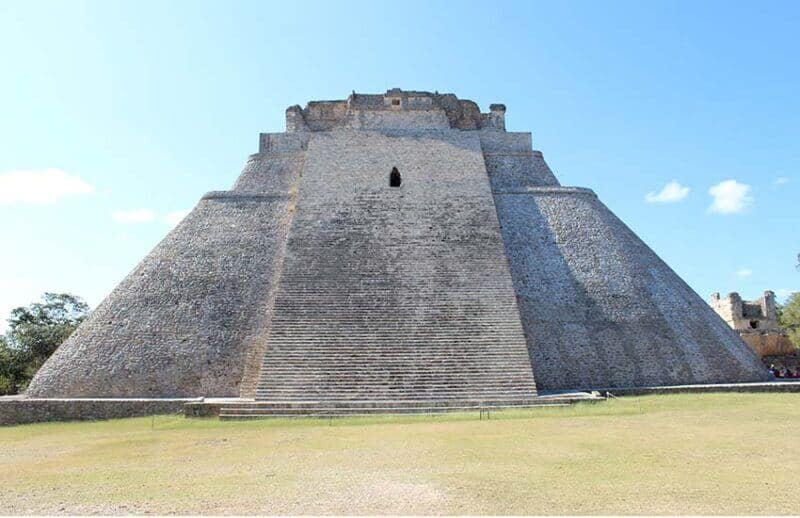
The architecture here is considered some of the best examples of the Puuc style. You can observe rich decorative elements on the structures, including gods, human figures, and animals. According to INAH, some of Uxmal’s phallic decorations were removed from structures in advance of Mexico’s ill-fated Empress Carlota visiting the site in 1865 to avoid upsetting her.
During our recent visit to Uxmal, many structures we had been able to access on a previous visit, as well as some areas of the site, were cordoned off to visitors.
Upon entering the site, you’ll pass by a chultún – an underground rainwater storage tank. Due to the water shortages in the region, the ancient Mayas built a complex system to collect and use rain.
Near the entrance is the beautiful 35-meter-tall pyramid called the House of the Magician, also referred to as the Pyramid of the Dwarf and the Pyramid of the Soothsayer.
Legend says that this pyramid, with its interesting cone-like shape and two facades facing east and west, was built magically overnight in response to a challenge by Uxmal’s ruler. The builder was said to be a dwarf who was the son of a sorceress and born from a turtle egg.
However, contrary to the legend, archaeologists have identified five building phases and multiple architectural styles within the House of the Magician. It is made up of five temples built in different periods.
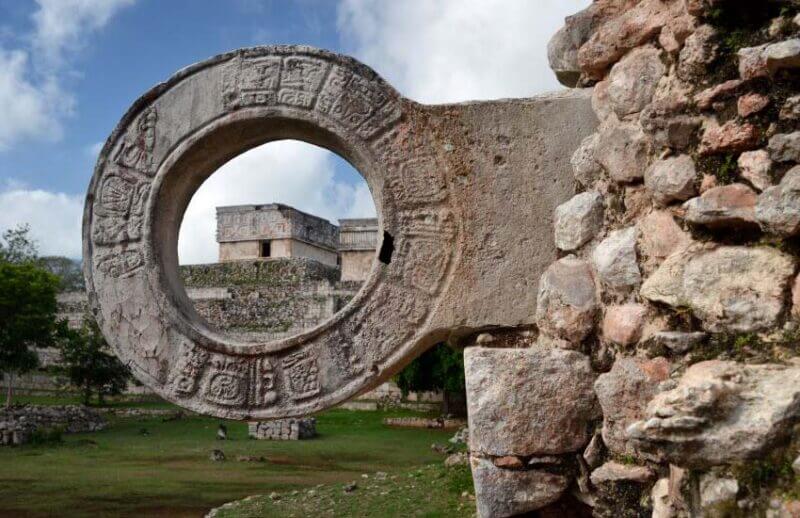
The pyramid’s western stairway is lined by long-nosed masks believed to be of the god Chaac. An upper area called Temple IV has a mask of the earth monster on its facade. Its open jaws create the entrance.
Near the House of the Magician is a square with four palace-like structures called the Quadrangle of the Birds. One building has a frieze with designs resembling a feather or palm-leaf roof and bird sculptures. This group of buildings has been identified as the residence of Uxmal’s ruler, Lord Chac.
Next to the Quadrangle of the Birds is a large palace complex with four structures situated around a courtyard called the Quadrangle of the Nuns — named by the Spanish priest, Diego López de Cogolludo. The Spanish had believed that Mayan priestesses resided in these rooms.
Vault lids discovered in the buildings have partial dates corresponding to the time of Lord Chac’s reign, according to INAH.
Although these buildings are called palaces, it is believed that this complex served administrative and non-residential purposes.
The main access to the Quadrangle of the Nuns is through a beautiful vault on the South Building. The facade designs are linked to deities and cosmogenic concepts said to inspire an intense sense of fertility. There are many decorative elements on the building facades, including masks of God Chaac, planet Venus symbols, double-headed snakes, human figures and houses. Tláloc, the ancient rain god of central Mexico, is also depicted here.
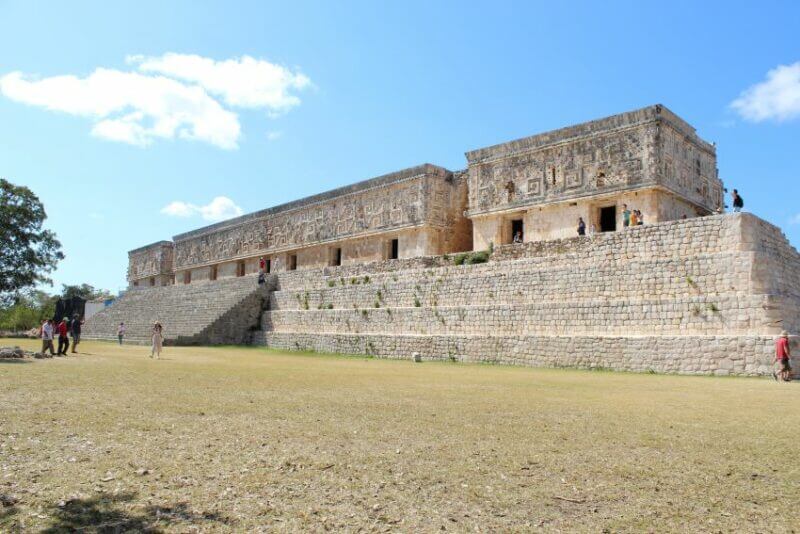
The North Building, a 26-room structure constructed on a 100-meter-long platform, is believed to be the most important due to its higher platform than the others. The building has a wide stairway in front with two temples on either side.
The other three buildings of the quadrangle also have many rooms and beautiful decorative elements worth seeing. The views from the South Building’s arch are stunning.
South of the Quadrangle of Nuns is the ball court, with two parallel structures and a playing area. Lord Chac is believed to have ordered the ball court’s construction, and INAH says the rings have inscriptions dating to A.D. 905.
Near the Ball Court, the East Portico, featuring a row of columns, is thought to have been where rituals and ceremonies were conducted before the ball games. Other speculated uses of the building include accommodating the players and storing their protective gear.
Towards the south of the site, on a large platform, is a spectacular 98-meter-long rectangular building called the Governor’s Palace, also built during Lord Chac’s reign. Considered a royal residence and the city’s principal administrative center, it is an extraordinary architectural creation with plenty for the visitor to observe. It’s also positioned to track the planet Venus’s movements as well as the maximum solar declinations that define solstices.
A large stairway provides access, and it has three sections separated by high vaults. The building’s facade is richly decorated and includes depictions of rulers and masks of Chaac.
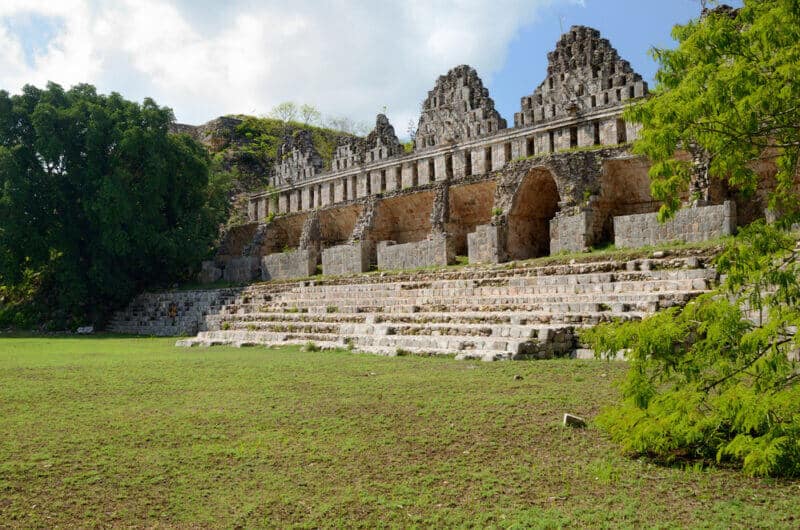
In front of the Governor’s palace is the Throne of the Jaguar. Situated on a small platform, it is a throne made of a double-headed Jaguar sculpture.
Next to the governor’s palace is another interesting structure called the House of the Turtles. This building, which has multiple entrances, has rooms with stools where occupants could sit or lie down. The facade’s top is decorated with columns and features a cornice with turtle sculptures. Turtles were important animals associated with the rain and earth. The views across the site from this area are magnificent.
The next notable building in this section is the Great Pyramid, measuring around 30 meters in height. It has a wide stairway, and at its top is a platform with a crowning structure called the Temple of the Macaws because of the macaw figures on its facade.
West of the site is a partially preserved building called the Dovecote with a beautiful roof comb. Unfortunately, this area was completely cordoned off during our recent visit.
There are several other structures to see on the site. After you’re done exploring, check out the Choco-Story Ecopark Chocolate Museum nearby to experience the history of cocoa, a Maya ceremony to the rain god Chaac and other park activities.
Thilini Wijesinhe, a financial professional turned writer and entrepreneur, moved to Mexico in 2019 from Australia. She writes from Mérida, Yucatán. Her website can be found at https://momentsing.com/
